To organize the aquarium, you need to place enough vegetation inside. Choosing greens for its design, it makes sense to turn your attention to the gun.
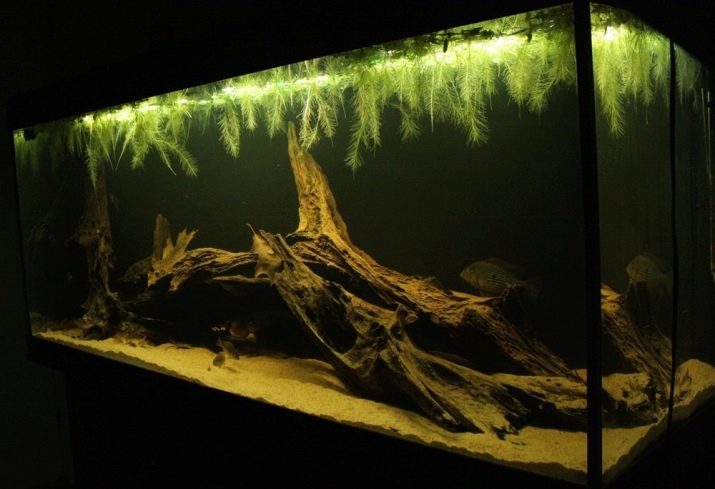
Description
The piston aquarium plant is also known under the names "water rose", "floating salad", and also "water lettuce". Outwardly, it resembles an ordinary head of cabbage. The root system of the plant is under water, and the leaves on short stems float on the surface. The length of one leaf varies from 20 to 25 centimeters, and the width reaches 10 centimeters. Rounded plates with narrow bases, painted in a green-blue tint, are collected in sockets.
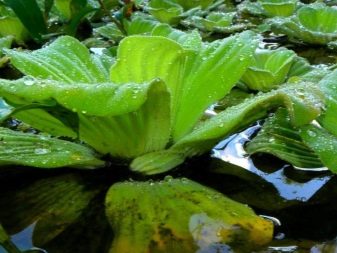
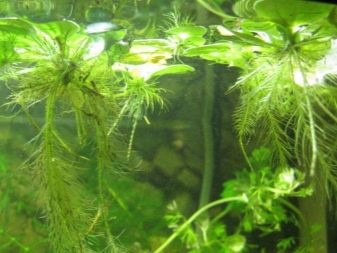
Elongated and slightly depressed veins are parallel to the length of the leaf. This gives the plates a corrugation effect, which additionally ensures the stability of the plant on the surface of the water. The surface of the leaves is covered with short gray hairs, preventing the plate from getting wet. The length of the cob is not more than a centimeter. It is shrouded in a leaf of light green color and is located on the top with several male flowers.
As a rule, their number ranges from 2 to 8 copies. Under two fused stamens is the only female flower with several ovules. Pistol self-pollination occurs on its own. However, the use of seeds formed in the fruits of the plant is no less spectacular. Active growth of culture begins with an increase in daylight hours. In addition to the appearance of new leaves, there is an increase in outlets (from 10 to 12 centimeters). In addition, lateral shoots are actively formed.This entire period lasts about a couple of months.
At the junction of summer and autumn, flowering can begin, but only in favorable conditions.
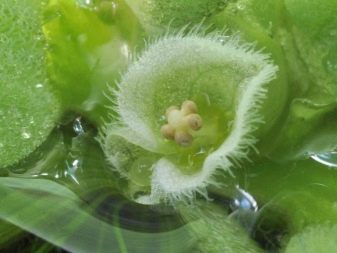

In nature, pistachus lives in the tropics of Africa, so high humidity and the same temperature are an integral condition for the development of this culture. The plant grows so fast that in a short period of time it covers the entire surface of the reservoir. Under natural conditions, the diameter of the outlet reaches 30 centimeters, while thin interwoven roots go under water by almost 60 centimeters.
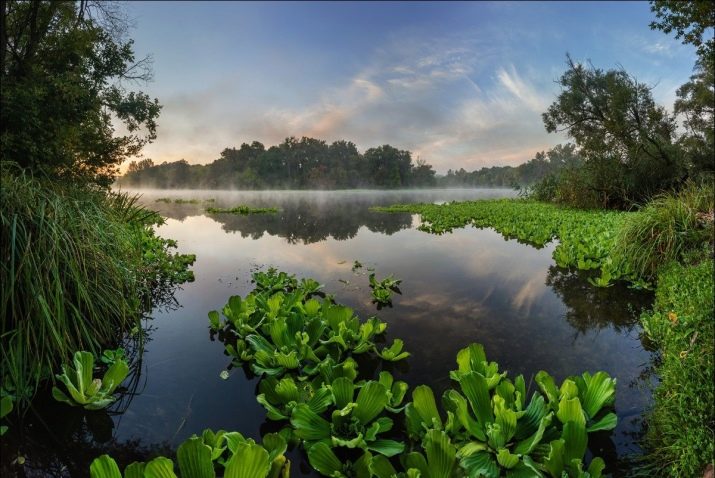
Varieties
Water salad has few types, but they all differ in the height of the "original" and are suitable for germination in an aquarium. Blue water salad is characterized by the presence of beautiful leaf plates in a blue hue. Most often, a floating pistol is chosen not for aquariums, but for the design of small ponds. Corrugated water cabbage is distinguished by miniature leaves with the same corrugated ends. The diameter of the plates ranges from 7 to 10 centimeters.
Variegated water lettuce has spotty leaves, the surface of which is also covered with strips of beautiful creamy yellow color. As for the names “layered pistol” or “teloresis pistol”, all these are simply different names for water salad.
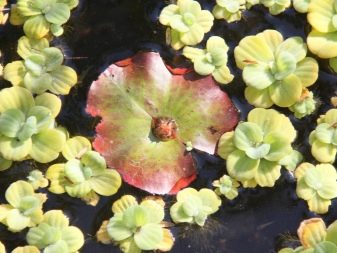
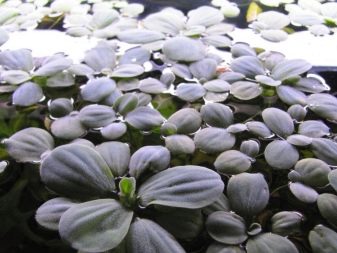
Growing conditions
Keeping a pistol in the aquarium is a fairly simple task. The temperature is recommended to be maintained in the range from 25 to 28 degrees. Lower indicators will not cause much damage to the plant, but the size of the outlets will be smaller. The rigidity and acidity of the liquid, in principle, do not play a special role, but it is good if the pH level remains in the range from 5 to 7. Too hard water will help slow down the development of the culture, and worsen the condition of the bushes. This implies the importance of regular water updates.
An important condition for the existence of a piston is a sufficient amount of light. In this case, she lacks natural sources, so she will have to use artificial ones. Incandescent lamps are not allowed to be used, since their use contributes to the appearance of burns on the plates. But luminescent devices will prove to be excellent. The required length of daylight reaches 12 hours. You can understand whether a plant has enough light by its appearance. A well-lit pistol opens the sockets during the day, and closes them at night.
Experts also recommend slightly covering the container with a lid, avoiding the occurrence of a greenhouse effect. Such a coating will provide the necessary level of humidity, and therefore further flowering of the crop.
In summer, lettuce can be exposed to insects. It will be treated as a normal plant. The diseased bush is removed from the aquarium, treated with pesticides according to the instructions, and must be washed under the tap before returning to the vessel.
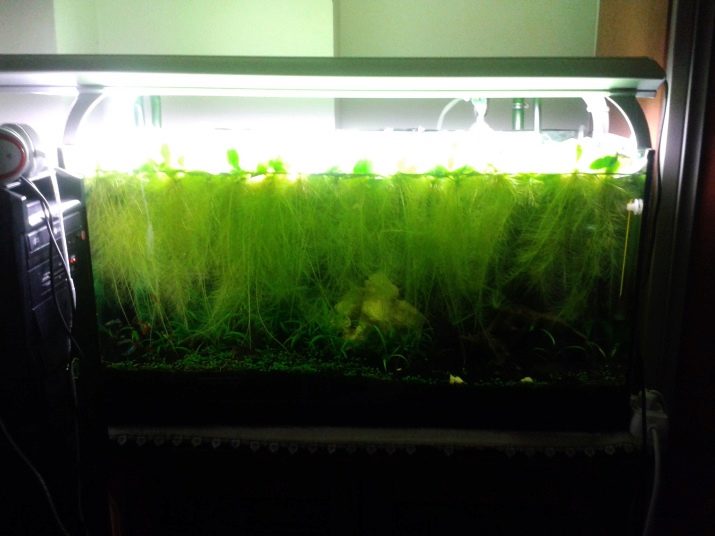
Proper care
The main components of water rose care are regular top dressing, as well as providing conditions for winter relaxation. It should be mentioned that sometimes thinning is necessary for water cabbage. If you let it grow uncontrollably, then it will flood the entire surface of the water, will create a strong shadow at the bottom and thereby deprive the necessary lighting of all the inhabitants of the aquarium.
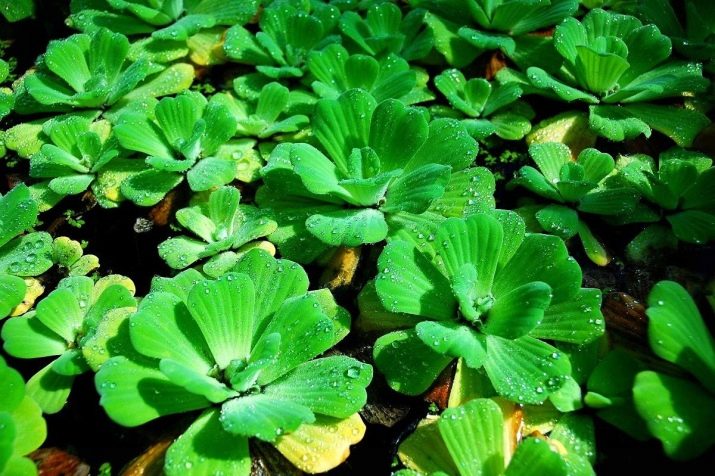
Top dressing
It is recommended to feed the pistol in the spring and summer, when there is an active vegetation. The best for this purpose are complex fertilizers, which necessarily contain iron in their composition. The number of dressings is determined as follows: per 100 liters of water accounts for only 1.5 to 2 grams of dry powder. In order to determine if the pistol lacks nutrients, it is necessary to carefully examine its roots. If they look as usual, then everything is in order, but if they began to increase, then the plant lacks organic substances.In addition, for water lettuce, it is important that the water in the tank has a sufficient amount of nitrates. The optimal soil for the culture is considered fertile and silty soil mixtures.
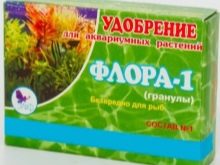
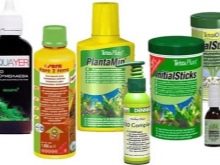

Winter rest period
As with most plants, the development of pistii changes in the winter. Its growth gradually stops at the end of summer. Almost all foliage falls and only a few small leaves remain on the bush. Subsidiary processes also slow down in their development. In this case, culture needs to ensure a soft transition to a state of rest, after which next spring it will be able to return to growth and growth with renewed vigor.
From the beginning of autumn, the temperature in the tank gradually decreases. Since this can affect the fish quite deplorably, it is likely that you will have to reset the pistol in another vessel for a while. The temperature of the liquid will have to be gradually lowered to a range of 17 to 19 degrees. When moving to a period of rest, it will be necessary to gradually reduce lighting. Fertilizing during these months is not applied at all, and water changes much less frequently.
It is important to understand that if you ignore these recommendations and, conversely, begin to increase the amount of light and useful elements, the water rose will gradually perish. First, the leaf sockets will begin to decrease, then the number of plates will be reduced to 4-5 pieces, and after the gun simply degenerates.
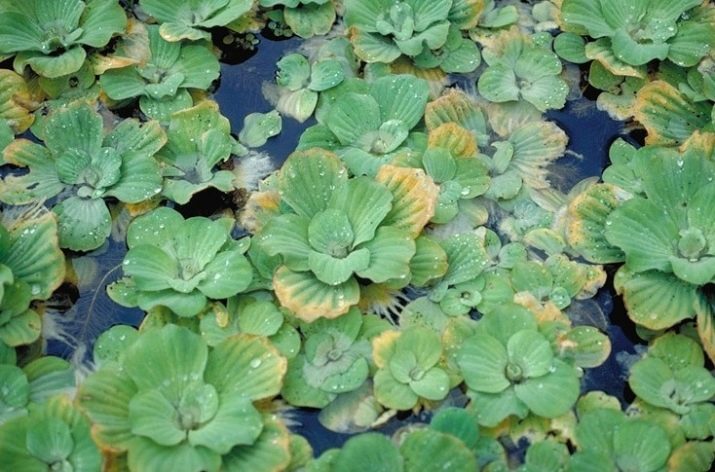
Breeding
Water lettuce is usually propagated either by seeds or processes. The easiest way to use the lateral processes or stolons. When the bush reaches 8 centimeters in diameter, small processes can be separated from it, which at that time created a couple of full-fledged leaves. On the stolons, full-fledged children resembling strawberries mustaches separate themselves. If the required shoots appear during the winter dormancy period, then they will have to be removed for conservation to the surface from peat moss and covered with a glass plate.
When the stolons are transplanted into a separate container, it will be important to maintain the water temperature at 11-13 degrees heat. In the spring they can already be transplanted into the main aquarium. In nature, by the way, children detach from the mother plant independently and fall into a new habitat with the help of the current.
If the pistol is decided to propagate with the help of seeds, then it will be necessary to collect the seed before the start of the spring months. In an aquarium, this process is problematic, since the seeds fall to the bottom and collecting them is quite difficult.

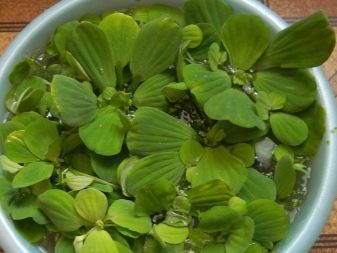
Possible problems
Despite the fact that a water rose is an unpretentious plant and has innate immunity to most common diseases, even it has problems. In hot summer, the plant often becomes a target for insects. Besides, piston is sometimes exposed to fungal or bacterial diseases in the case when the plant itself is no longer young, but somehow weakened. In this case, unfortunately, culture cannot be saved; it perishes. Immediately remove the bush from the aquarium, and then carry out a complete water change. Piston infection can also occur if the transplant is unsuccessful. To prevent this situation, it is necessary to extract the plant again, rinse its roots thoroughly, and then remove it for about a month in a separate container. When quarantine is over, lettuce can be returned to the general aquarium.
If the bush turns yellow leaves and it even begins to rot, there may be several reasons for this. The problem arises either due to insufficient lighting, or due to the tightly closed lid of the aquarium. In addition, excess or insufficient fertilizer or the effects of drugs used to treat fish may be to blame.

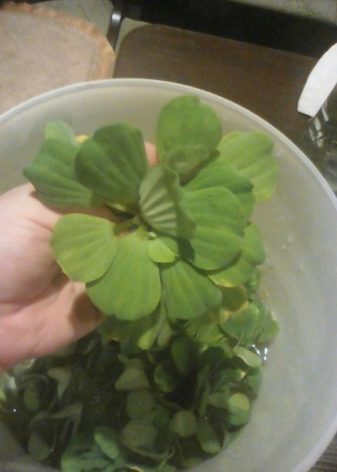
Some aquarium inhabitants, such as snails or other mollusks, often spoil the leaves. What begins as a violation of the decorative attractiveness of the plant, as a result, can even lead to the death of pistii.
See the video below about piston aquarium plants.










